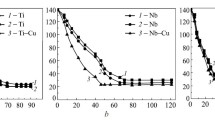Abstract
The temperature dependence of advancing and receding contact angles has been determined for tin and its alloys with silicon, aluminum, and iron on the surface of a solidified glass mass. The advancing and receding contact angles of melts containing iron differ from those of melts containing silicon and aluminum. The difference becomes more pronounced in the low-temperature range as the iron content in the melt increases.
Similar content being viewed by others
REFERENCES
V. I. Nizhenko and Yu. I. Smirnov, “Setup for determining the surface properties and density of melts with specimens fed semi-automatically into the heating zone, ” in: Methods of Investigation and Properties of the Phase Boundary of Contacting Phases [in Russian], Nauk. Dumka, Kiev (1977).
J. J. Brennan and J. A. Pask, “Effect of nature of surfaces on wetting of sapphire by liquid aluminium, ” J. Amer. Ceram. Soc., 51, No. 10, 569 (1968).
Author information
Authors and Affiliations
Rights and permissions
About this article
Cite this article
Nizhenko, V.I. Advancing and Receding Contact Angles of Tin and Its Alloys on the Surface of a Solidified Glass Mass. Powder Metallurgy and Metal Ceramics 41, 296–299 (2002). https://doi.org/10.1023/A:1020539600785
Issue Date:
DOI: https://doi.org/10.1023/A:1020539600785



